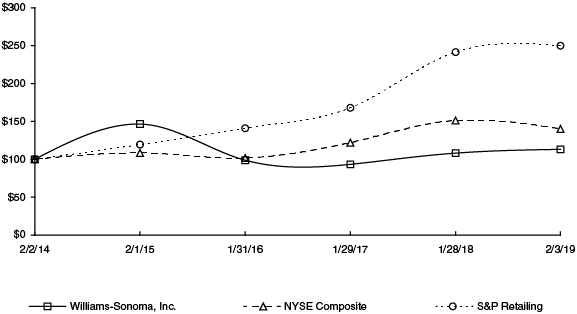were repaid in the fourth quarter of fiscal 2017. As of February 3, 2019, we had $300,000,000 outstanding under our term loan. The term loan matures on January 8, 2021, at which point all outstanding principal and any accrued interest must be repaid. Additionally, as of February 3, 2019, a total of $11,732,000 in issued but undrawn standby letters of credit were outstanding under the credit facility. The standby letters of credit were issued to secure the liabilities associated with workers’ compensation and other insurance programs.
Additionally, we have three unsecured letter of credit reimbursement facilities, which were amended during the year, for a total of $70,000,000, of which an aggregate of $6,820,000 was outstanding as of February 3, 2019. These letter of credit facilities represent only a future commitment to fund inventory purchases to which we had not taken legal title.
We are currently in compliance with all of our financial covenants under the credit facility and, based on our current projections, we expect to remain in compliance throughout fiscal 2019. We believe our cash on hand, in addition to our available credit facilities, will provide adequate liquidity for our business operations over the next 12 months.
Cash Flows from Operating Activities
For fiscal 2018, net cash provided by operating activities was $585,986,000 compared to $499,704,000 in fiscal 2017. For fiscal 2018, net cash provided by operating activities was primarily attributable to net earnings adjusted fornon-cash items, an increase in accounts payable and accrued expenses and other liabilities, as well as an increase in gift card and other deferred revenue, partially offset by an increase in merchandise inventories and prepaid expenses and other assets and a decrease in income taxes payable. This represents an increase in net cash provided by operating activities compared to fiscal 2017 primarily due to an increase in accounts payable and accrued expenses and other liabilities offset by a change in income taxes payable.
For fiscal 2017, net cash provided by operating activities was $499,704,000 compared to $524,709,000 in fiscal 2016. For fiscal 2017, net cash provided by operating activities was primarily attributable to net earnings adjusted fornon-cash items, an increase in income taxes payable, as well as deferred rent and lease incentives, partially offset by an increase in merchandise inventories. This represents a decrease in net cash provided by operating activities compared to fiscal 2016 primarily due to an increase in merchandise inventories and a decrease in net earnings, partially offset by a decrease in income taxes paid in fiscal 2017 compared to fiscal 2016.
Cash Flows from Investing Activities
For fiscal 2018, net cash used in investing activities was $187,899,000 compared to $269,760,000 in fiscal 2017, and was primarily attributable to purchases of property and equipment. Net cash used in investing activities compared to fiscal 2017 is lower due to the acquisition of Outward in fiscal 2017 (see Note O to our Consolidated Financial Statements).
For fiscal 2017, net cash used in investing activities was $269,760,000 compared to $196,975,000 in fiscal 2016, and was primarily attributable to purchases of property and equipment and the acquisition of Outward. Net cash used in investing activities compared to fiscal 2016 increased due to the acquisition of Outward.
Cash Flows from Financing Activities
For fiscal 2018, net cash used in financing activities was $450,066,000 compared to $51,707,000 in fiscal 2017. For fiscal 2018, net cash used in financing activities was primarily attributable to repurchases of common stock of $295,304,000 and the payment of dividends of $140,325,000. Net cash used in financing activities compared to fiscal 2017 decreased primarily due to term loan borrowings in fiscal 2017 and an increase in repurchases of common stock in fiscal 2018.
For fiscal 2017, net cash used in financing activities was $51,707,000 compared to $305,806,000 in fiscal 2016. For fiscal 2017, net cash used in financing activities was primarily attributable to repurchases of common stock of $196,179,000 and the payment of dividends of $135,010,000, partially offset by proceeds from issuance of long-term debt of $300,000,000. Net cash used in financing activities compared to fiscal 2016 decreased primarily due to proceeds from the issuance of long-term debt, partially offset by an increase in repurchases of common stock.
34
